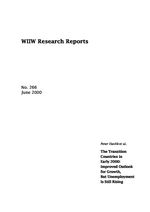The Transition Countries in Early 2000: Improved Outlook for Growth, But Unemployment Is Still Rising
Peter Havlik
wiiw Research Report No. 266, June 2000
83 pages including 27 Tables and 8 Figures
Both the current economic situation and the short-term growth outlook of virtually all countries in transition are better than at any time during the last decade. Driven by higher import demand from the EU, the Central and East European countries are enjoying an export boom which fuels their GDP growth. Russia has been profiting from rising world market commodity prices while its industry is still cashing on the import substitution effects after devaluation. Industry has been the main contributor to the economic recovery of the region whereas agriculture suffers from a severe drought. A strong growth of industrial production, coupled with further lay-offs of redundant workers, translates into impressive improvements in the labour productivity. The cost advantages of successful CEE producers are rapidly improving. With further progress in transition these cost advantages will certainly contribute to more re-allocation of production to this region.
The less pleasant consequence of the rising efficiency has been rising unemployment. Double-digit unemployment rates have now become a rule. Apart from the truly disastrous labour market situation in several countries of former Yugoslavia, unemployment has recently acquired dramatic dimensions especially in Bulgaria and in the Slovak Republic. Moreover, nowhere in the region is there hope for a marked improvement. And even more than in the rest of Europe, the CEECs' unemployment patterns display distinct regional, gender, age and minority differences which have serious implications for economic and social policies.
Foreign trade has once again become an engine of CEECs' economic growth; exports were growing by 30% in current euro terms during the first quarter of 2000. The development of imports was nearly equally dynamic (+28%), and the CEECs' trade deficit further increased - mostly on account of a further deterioration of the trade balance in Poland. Rapidly growing trade with the EU has been the main cause for the recent dynamic developments whereby CEECs' terms of trade deteriorated. The recent expansion of CEECs' exports occurred despite a noticeable appreciation of their currencies. FDI inflows have increased substantially in several CEECs who not long ago had been either sceptical to foreign ownership (especially Poland and the Czech Republic) or unattractive (Bulgaria and Romania).
Economic growth is expected to gain momentum in all transition countries covered by this report during the next two years. While inflation will slightly increase in 2000, it will remain moderate and will come down next year. Current account deficits are likely to expand, but no immediate dangers (with the possible exception of Poland) are on the horizon in the forecasting period. A major concern is the stubbornly high and rising unemployment which has to be addressed appropriately.
Keywords: economic growth, labour market, unemployment, foreign trade
JEL classification: O57, O15, J21, F14, F15, F16
Countries covered: Bulgaria, Croatia, Czechia, Hungary, North Macedonia, Poland, Romania, Russia, Slovakia, Slovenia, Ukraine, SEE, Visegrad countries
Research Areas: Macroeconomic Analysis and Policy, Labour, Migration and Income Distribution, International Trade, Competitiveness and FDI
